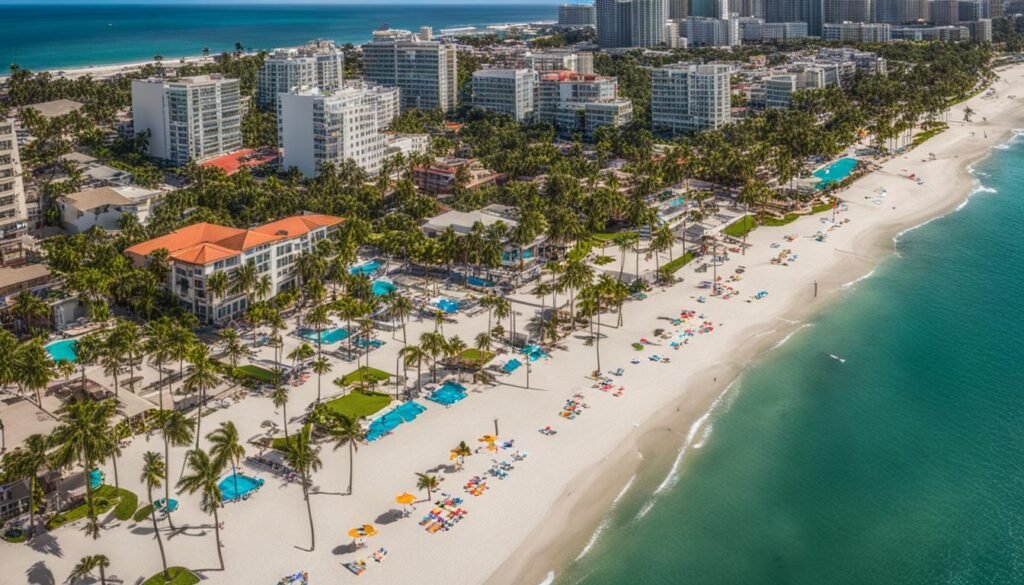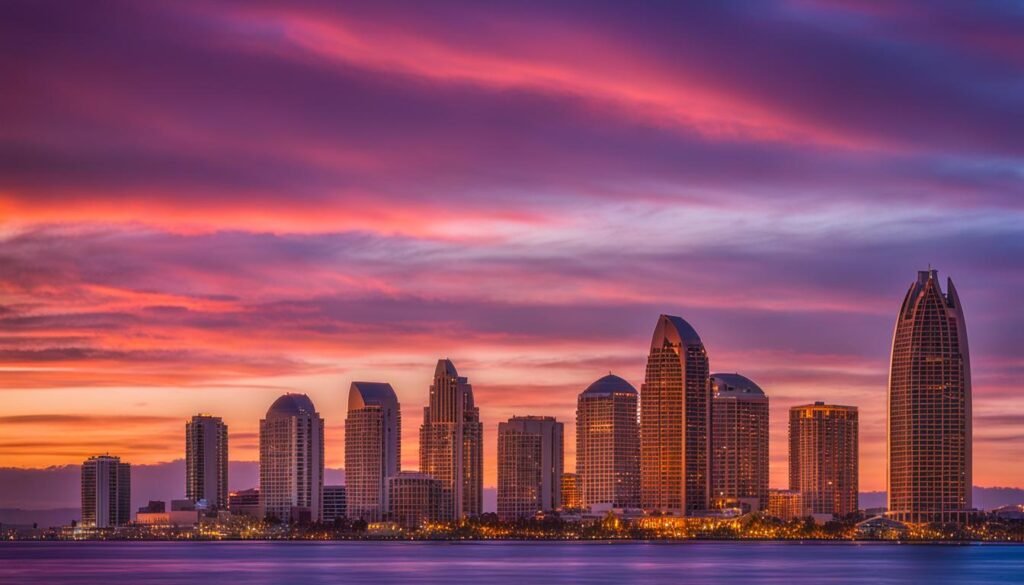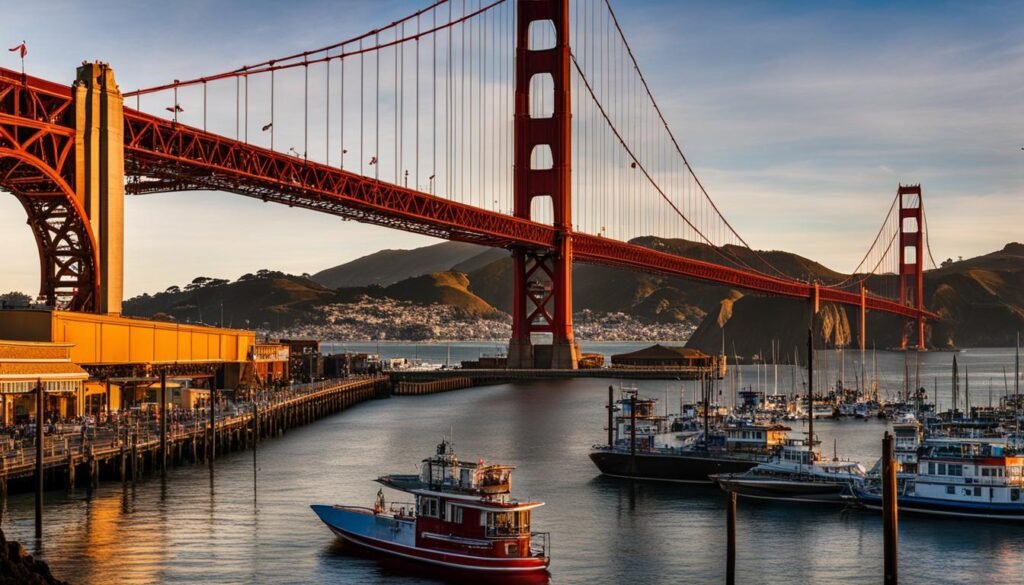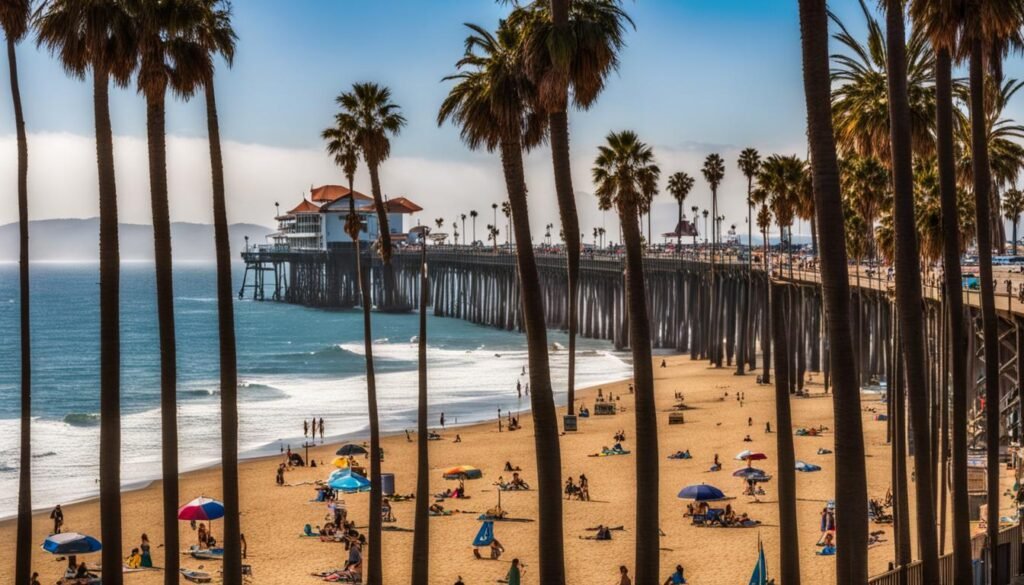Death Valley National Park is home to a multitude of captivating attractions that are sure to leave visitors in awe. From otherworldly salt flats to golden sand dunes, the park boasts some of the most stunning landscapes on Earth. Whether you’re a nature enthusiast or an adventure seeker, Death Valley offers a plethora of must-see attractions that will take your breath away.
Key Takeaways:
- Death Valley National Park is renowned for its striking landscapes and diverse attractions.
- From salt flats to sand dunes, the park offers a variety of natural wonders to explore.
- Visitors can enjoy hiking, photography, and sightseeing at the park’s many iconic landmarks.
- Death Valley is a must-visit destination for nature enthusiasts and adventure seekers alike.
- Plan your visit to Death Valley to experience the beauty and wonder of this extraordinary national park.
How to Get to Death Valley
Death Valley National Park is located in Southern California, approximately four hours northeast of Los Angeles and two hours west of Las Vegas, Nevada. To access this breathtaking destination, you have convenient options for traveling by air or road.
If you’re flying in, the recommended approach is to fly into Las Vegas and rent a car. This allows for a shorter and more convenient drive to the park, giving you more time to explore the wonders of Death Valley. Flying to Las Vegas also offers the opportunity to experience the vibrant city before embarking on your desert adventure.
If you’re planning a road trip through California, Death Valley can be easily included in your itinerary. The park is situated within a reasonable driving distance from other popular attractions like Mammoth Lakes and the Alabama Hills. Incorporating Death Valley into your road trip allows you to witness the stunning landscapes and unique features this region has to offer.
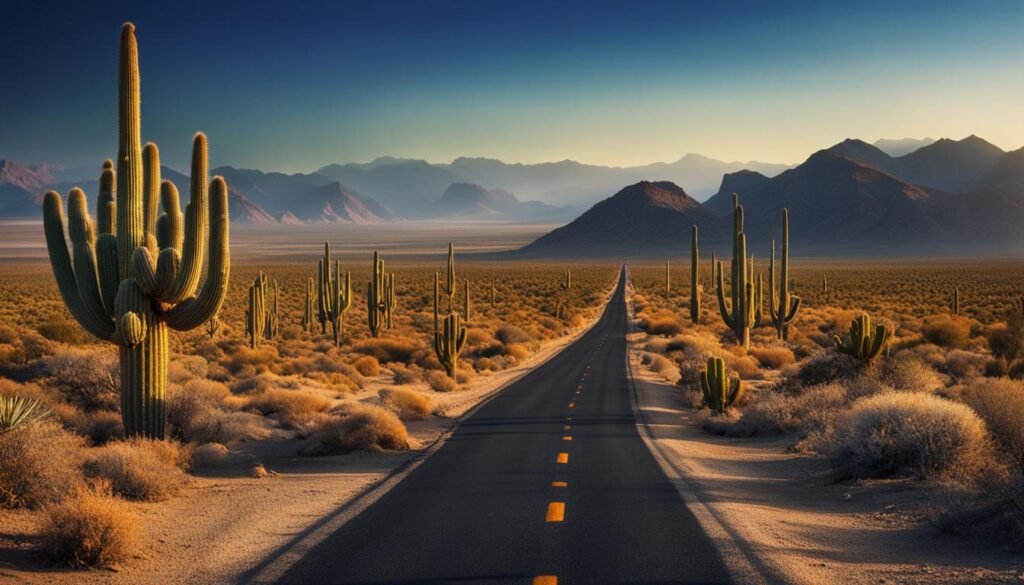
Whether you choose to fly or drive, reaching Death Valley National Park is an adventure in itself. Prepare for a journey filled with otherworldly beauty and unforgettable experiences.
When to Visit Death Valley
The best time to visit Death Valley depends on personal preferences and the experience you’re looking for. The park experiences extremely high temperatures during the summer months, so it’s advisable to avoid visiting during this time.
The most popular time to visit is in the spring when the weather is pleasant, the skies are clear, and vibrant wildflowers carpet the park. Spring offers an ideal climate for outdoor activities such as hiking, photography, and wildlife spotting. The temperatures are comfortable, ranging from the mid-70s to mid-90s Fahrenheit (mid-20s to low 30s Celsius), making it a great time to explore Death Valley’s unique landscapes.
Fall and winter also offer enjoyable temperatures for exploring the park, but winter months may bring cooler temperatures and snow-capped mountains in the distance. Fall is another great time to visit as the temperatures cool down, ranging from the mid-70s to high 80s Fahrenheit (mid-20s to low 30s Celsius). This is a quieter time in the park, allowing visitors to enjoy the serene beauty of Death Valley without the crowds.
Whether you’re looking to avoid the scorching summer heat or enjoy the bloom of wildflowers, planning your visit to Death Valley during the spring or fall is recommended. The mild temperatures and clear skies create the perfect setting for exploring the park’s mesmerizing attractions.

Things to Do in Death Valley
Death Valley offers a plethora of activities and attractions that cater to various interests. Whether you’re a nature enthusiast or an adventure seeker, there is something for everyone in this breathtaking national park. Here are some must-do activities in Death Valley:
- Hiking through the awe-inspiring Golden Canyon, an otherworldly landscape carved by time and elements.
- Walking across the mesmerizing salt flats of Badwater Basin, the lowest point in North America.
- Watching the sunrise at Zabriskie Point and experiencing the vivid hues of the surrounding badlands.
- Climbing the colorful hills at Artist’s Palette and witnessing the vibrant mineral deposits.
- Visiting Racetrack Playa, where mysteriously moving rocks create intriguing trails.
- Exploring the unique landscape of Devil’s Golf Course, characterized by its salt crystal formations.
- Embarking on a hike to the ghost town of Rhyolite, an intriguing glimpse into the region’s mining past.
Immerse yourself in the wonders of Death Valley by indulging in these activities. Each experience offers a unique perspective on the park’s fascinating geology and natural beauty. Capture unforgettable memories and be prepared to be in awe of the grandeur that Death Valley has to offer.

Experience Death Valley’s Breathtaking Viewpoints
In addition to the various activities, Death Valley also boasts several breathtaking viewpoints that offer panoramic vistas of the park’s stunning landscapes. Some notable viewpoints include:
- Dante’s View: Situated at an elevation of 5,475 feet, this viewpoint provides a stunning overlook of Death Valley’s expansive terrain.
- Zabriskie Point: Famous for its mesmerizing sunrise views, Zabriskie Point offers unparalleled panoramas of the surrounding badlands and the Amargosa Range.
- Artist’s Drive: This scenic road leads to several viewpoints that showcase the vibrant colors and geological formations of Artist’s Palette.
- Ubehebe Crater: Venture to the edge of this massive volcanic crater to witness its magnitude and enjoy the striking desert backdrop.
Make sure to include these viewpoints in your itinerary to capture stunning vistas and create lasting memories of your trip to Death Valley.
What to Know Before Visiting Death Valley
Before heading to Death Valley, it’s important to be well-prepared for your visit. Here are some essential travel tips and safety guidelines to keep in mind to ensure a smooth and enjoyable experience.
Download Offline Maps for Navigation
One of the first things to do before visiting Death Valley is to download offline maps on Google Maps and AllTrails. Cell service is limited in most parts of the park, so having offline maps will help you navigate and explore without any connectivity issues.
Stay Hydrated and Carry Water
Death Valley is notorious for its extreme heat, especially during the summer months. It’s crucial to stay hydrated and carry plenty of water with you at all times. The park recommends drinking at least one gallon of water per day to prevent dehydration.
Be Aware of Entrance Fee and Opening Hours
Before entering Death Valley National Park, be sure to check the park’s entrance fee and opening hours. The fees vary depending on the type of vehicle and the duration of your stay. It’s advisable to arrive early in the morning to make the most of your visit and avoid crowds.
Come Prepared for the Rugged Landscape
Death Valley’s landscape is rugged and remote, so it’s essential to come prepared with necessary supplies. Pack enough food, fuel, and clothing suitable for the desert environment. It’s a good idea to bring sunscreen, hats, and sunglasses to protect yourself from the intense sun.
By following these travel tips and safety guidelines, you’ll be well-equipped to explore and enjoy all that Death Valley has to offer. Remember to plan ahead, stay hydrated, and take necessary precautions to make your visit a memorable and safe experience.
Where to Stay in Death Valley
When visiting Death Valley, you have a variety of accommodation options to choose from. Whether you prefer rustic camping, modern amenities, or luxurious comforts, there is something for every type of traveler.
Furnace Creek Campground
If you’re seeking a more rustic experience, the Furnace Creek Campground is a perfect choice. This campground offers basic amenities and the opportunity to enjoy the starry night sky. Set up your tent and immerse yourself in the natural beauty of Death Valley.
The Ranch at Death Valley
For a mix of comfort and convenience, The Ranch at Death Valley is an excellent option. It offers modern accommodations, a pool, and easy access to key attractions in the park. After a day of exploring, unwind in the comfort of your room or take a refreshing dip in the pool.
Panamint Springs Resort
If you’re looking for a small, rustic resort experience, Panamint Springs Resort is the place to be. This resort offers lodging, camping, and RV services. Immerse yourself in the tranquil atmosphere and enjoy the breathtaking views surrounding the resort.
The Inn at Death Valley
For a more luxurious stay, The Inn at Death Valley is a top choice. With AAA-rated four-diamond accommodations and a rich history, this inn offers a truly memorable experience. Indulge in luxurious amenities, dine at exquisite restaurants, and immerse yourself in the charm of Death Valley’s past.
Choose the accommodation that best suits your needs and preferences, and make the most of your stay in Death Valley.
Conclusion
Death Valley National Park is a captivating destination that offers a multitude of attractions and highlights for visitors to explore. The park’s otherworldly landscapes and unique features make it a truly unforgettable experience. From the breathtaking views of iconic landmarks to the exhilarating adventures on the diverse trails, there is something for everyone in Death Valley.
Whether you’re drawn to the mesmerizing salt flats, the golden sand dunes, or the vibrant badlands, Death Valley’s attractions showcase the stunning beauty and diversity of the California desert. The park is a must-visit for nature enthusiasts, adventure seekers, and anyone looking to immerse themselves in awe-inspiring natural wonders.
Plan your visit to Death Valley and prepare to be amazed by the wonders that await you. With its abundance of attractions, endless places to visit, and unforgettable highlights, Death Valley promises an adventure of a lifetime. Don’t miss out on the opportunity to explore this remarkable destination and create lifelong memories.
FAQ
What are some must-see attractions in Death Valley?
Death Valley offers a range of captivating attractions, including the mesmerizing salt flats of Badwater Basin, the colorful hills at Artist’s Palette, and hiking through the Golden Canyon. Other must-see attractions include Zabriskie Point, Racetrack Playa, and the Rhyolite Ghost Town.
How do I get to Death Valley?
Death Valley National Park is located approximately four hours northeast of Los Angeles and two hours west of Las Vegas, Nevada. You can fly into Las Vegas and rent a car for a shorter and more convenient drive to the park. Alternatively, you can include Death Valley as part of a California road trip.
When is the best time to visit Death Valley?
The best time to visit Death Valley is in the spring when the weather is pleasant, the skies are clear, and vibrant wildflowers carpet the park. Fall and winter also offer enjoyable temperatures for exploring the park, but winter months may bring cooler temperatures and distant snow-capped mountains.
What are some things to do in Death Valley?
In addition to exploring the park’s iconic landmarks, there are plenty of activities to enjoy in Death Valley. You can hike the park’s breathtaking trails, visit the Devil’s Golf Course, watch the sunrise at Zabriskie Point, and witness the moving rocks at Racetrack Playa. Don’t forget to explore the historic Rhyolite Ghost Town as well.
What should I know before visiting Death Valley?
Before visiting Death Valley, it’s important to download offline maps, as cell service is limited in most of the park. Staying hydrated is crucial due to the extreme heat, so be sure to bring plenty of water. Visitors should also be aware of the park’s entrance fee and opening hours, and come prepared with necessary supplies for the rugged and remote landscape.
Where can I stay in Death Valley?
Death Valley offers a range of accommodation options to suit various preferences. The Furnace Creek Campground provides a rustic experience, while The Ranch at Death Valley offers modern accommodations and convenience. Panamint Springs Resort provides a small, rustic resort experience, and The Inn at Death Valley offers a luxurious option with AAA-rated four-diamond accommodations.



